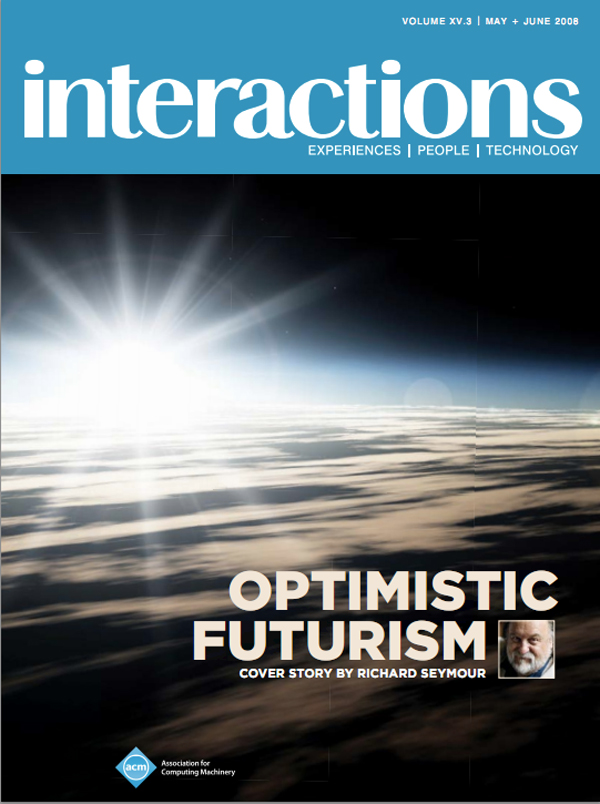Authors:
Eli Blevis, Shunying Blevis
This issue begins the first of a series of collected images concerned with sustainability and interaction design. In keeping with the new theme of interactions magazinepromoting interactionsit is our hope that these images will stimulate many discussions, actions, and reactions. The subtlety of images is here offered as a complement to the potentially precise, yet oftentimes reductive expression of text.
By now issues of sustainability make frequent appearance in the everyday press; most readers of interactions may have accepted the need for acting more sustainably with respect to interaction design, its contexts, and its effects. The big question is what to do differently. The images that followsome of which are more connected to the context of the effects of interaction design than directly to interaction design itselfare all targeted at fostering a collective way of looking differently at the materials and machinery of unsustainable consumption with an eye toward doing things differently in the future. These images are quite broad in scope, and the relationship between the contexts pictured and interactivity is very broadly interpreted.
The images and descriptions that follow are not necessarily solution concepts for more sustainable interactive design, nor are they necessarily observations targeted at raising awarenessawareness is already high. Rather, these images are targeted at stimulating insights about how to use the materials of interactive information technologies differently as designers to "redirect"the ways in which these materials play a role in everyday economies and ecologies [1].
In 1947, J. Gordan Lippincott published a book called Design for Business. In it he has a chapter entitled "ObsolescenceThe Keynote of a New Prosperity." Here's a short extract: "Our custom of trading in our automobiles every year, of having a new refrigerator, vacuum cleaner, or electric iron in every three or four years is economically sound. Our willingness to part with something before it is completely worn out is a phenomenon noticeable in no other society in history. It is truly an American habit, and it is soundly based on our economy of abundance. It must be further nurtured even though it is contrary to one of the oldest inbred laws of humanitythe law of thriftof providing for the unknown and often-feared day of scarcity [2]."
It is doubtful that anyone would write such an opinion nowadays [3]. Nonetheless, it is incumbent on us as interaction designers to understand the ways in which such opinions common in the past half century have designed our present ways of consuming products, especially those built with the materials of information technologies. Such understandings are required to provide the insights needed to design sustainable alternativesboth material and systemicto the unsustainable proposition of premature obsolescence as a necessary correlate to prosperity. Moreover, the example of consumption set in America and in a few other countries as well cannot scale globally.
The images presented here are nearly all recent and taken at various places in the world, opportunisticallythe contrasts and similarities between these different places are part of the point of collecting them together here in series. They are not necessarily chosen to work together aesthetically as a set. In this first collection, we present a broadly constructed group of three images from mainland China and three from the U.S.
We would love for readers to submit their own images of sustainability. For more information please see the online version of interactions, http://interactions.acm.org.
1. The notion of design in the perspective of sustainability as a "redirective practice" is owed to Tony Fry. His forthcoming book, Design Futuring: Sustainability, Ethics, and New Practice from Berg Publishers, continues this notion.
2. Lippincott, J. Gordon. Design for Business. Chicago: Paul Theobald And Company, 1947, 14-15.
3. There are many examples of sustainability aware business press books, such as Paul Hawken, Amory B. Lovins, and L. Hunter Lovins' Natural Capitalism: Creating the Next Industrial Revolution (1999) as an early example. A short media piece called "The Story of Stuff" by Annie Leonard (http://www.storyofstuff.com/) also provides a modern counterpoint to Lippincott's point of view.
Eli Blevis
Indiana University
[email protected]
Shunying Blevis
Designer
[email protected]
About the Authors
Eli Blevis serves on the faculty in the Human-Computer Interaction Design program of the School of Informatics at Indiana University, Bloomington. Dr. Blevis's primary area of research, and the one for which he is best known, is sustainable interaction design. This area of research and Dr. Blevis's core expertise are situated within the confluence of human computer interaction as it owes to the computing and cognitive sciences, and design as it owes to the reflection of design criticism and the practice of critical design. Dr. Blevis has published more than 40 articles and papers and has given several invited colloquia internationally on sustainable interaction design and the larger context of notions of design.
Shunying Blevis is a fashion designer who lives and works in Bloomington, Indiana.
DOI: http://doi.acm.org/10.1145/1353782.1353788
©2008 ACM 1072-5220/08/0500 $5.00
Permission to make digital or hard copies of all or part of this work for personal or classroom use is granted without fee provided that copies are not made or distributed for profit or commercial advantage and that copies bear this notice and the full citation on the first page. To copy otherwise, to republish, to post on servers or to redistribute to lists, requires prior specific permission and/or a fee.
The Digital Library is published by the Association for Computing Machinery. Copyright © 2008 ACM, Inc.




 Figure.
Figure. Figure.
Figure.



Post Comment
No Comments Found